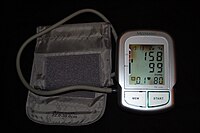
Photo from wikipedia
OBJECTIVE To evaluate the outcome of various surgical approaches in the treatment of renovascular hypertension (rHTN) and midaortic syndrome (MAS) in children. METHODS We performed a retrospective chart review of… Click to show full abstract
OBJECTIVE To evaluate the outcome of various surgical approaches in the treatment of renovascular hypertension (rHTN) and midaortic syndrome (MAS) in children. METHODS We performed a retrospective chart review of patients who underwent surgery for rHTN from 2010 to 2018 at our center under the care of a multidisciplinary team. Operative interventions included mesenteric artery growth improves circulation (MAGIC), tissue expander-stimulated lengthening of arteries (TESLA), aortic bypass using polytetrafluorethylene (PTFE) , renal artery re-implantation, and autotransplantation. MAGIC procedure utilizes the meandering mesenteric artery as a free conduit for aortic bypass. TESLA procedure is based on lengthening the normal distal aorta and iliac arteries by gradual filling of a retroaortic tissue expander over several weeks followed by resection of the stenotic aorta and subsequent primary reconstruction. RESULTS Thirty-nine patients were identified, 10 with isolated renal artery stenosis (iRAS), 26 with MAS, and 3 with systemic inflammatory vasculitis. Median age at presentation and surgery were 6.4 (range 0-16.3 years) and 9.3 years (range 0 days-9.2 years), respectively. MAS-associated syndromes included neurofibromatosis 1 (15.4%) and Williams syndrome (5.1%), though most cases were idiopathic. At surgery, 33.3% had stage 1 hypertension (HTN), 53.8% had stage 2 HTN and 12.8% had normal blood pressure on a median of 3 antihypertensive medications. Follow-up of 37 patients at a median of 2.5 years demonstrated normal blood pressure in 86.1%, stage 1 HTN in 8.3%, and stage 2 HTN in 5.6% with a median of 1 medication for the entire cohort. CONCLUSIONS Patterns of vascular involvement leading to renovascular hypertension in children are variable and complex requiring thoughtful multidisciplinary planning and surgical decision-making. MAGIC and TESLA procedures provide feasible approaches for aortic bypass and reconstruction using autologous tissues and result in normalization of blood pressure in 85% of children 2.5 years after surgery.
Journal Title: Journal of vascular surgery
Year Published: 2020
Link to full text (if available)
Share on Social Media: Sign Up to like & get
recommendations!